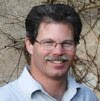After a hectic Spring, I finally had a chance to tackle the first furniture piece from the legacy redwood project. The first "chunk" to be used was really more of a waste piece that was left over after all the larger pieces for milling were separated from the original round. It was a funny little triangular piece whose shape was complete happenstance.
This piece had a big bark inclusion and had many large cracks and splits that precluded slicing it up. So, the task was to see what could be made of it as is. After playing around with various orientations I settled on a rather unconventional plan to use if tipped up on its point as a console table base.
The real trick to this piece was to keep 70 lbs of wood and glass stable. You can see in this drawing that the original idea was to have a steel post inserted into the bottom of the wood. After more thought and consultation with my personal engineering guru, David, that idea was abandoned for an approach that involved a steel bracket that could cradle the slab and bolt to it. I had the bracket fabricated by local metal artists Paul and Forrest Cheney of Cheney Metals. The bracket bolts to the solid wenge base, and then attaches to the wood slab with lag screws.
Before the wood could be mounted in the bracket, though, the severe checking would have to be dealt with to stabilize the slab. To do that, I ran two 16" long screws made for log cabin construction all the way into the slab parallel to each side to bridge the major sections of the slab.
Once everything was secured, it was just a matter of adding a glass top, along with a steel rod to support the glass in the bark void.
With a good penetrating oil finish the figure really popped out, and this little afterthought of a chunk became a beautiful piece of furniture.
The biggest problem my client will have now is deciding which side to display.
Stay tuned for the next installment as this project continues on.



























